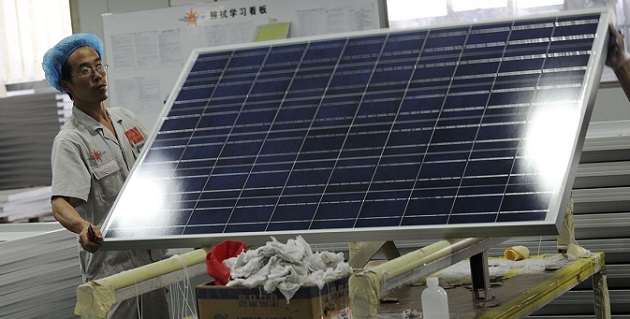China has overtaken Germany to become the world’s biggest solar market in 2013, with newly-installed solar capacity in the country jumping 232 per cent to 12 gigawatts (GW) from a year ago, a new study has found.
This milestone is credited to the country’s government policies on renewable energy which are now spurring solar installations in industrial zones and large companies’ rooftops, as well as in public infrastructure and in rural communities.
This achievement is backed by US$23.56 billion of industry financing, almost equivalent to the entire amount raised in Europe, said the Global Renewable Energy Report 2014, published on Monday by Hanergy Holding Group (Hanergy) and China New Energy Chamber of Commerce (CNECC).
Germany’s newly installed capacity in 2013 dropped by 56.5 per cent to 3.3GW, while in Italy, it sank by 55 per cent year-on-year to 1.6GW, said the report, which drew on data from Bloomberg New Energy Finance, GlobalData and Hanergy and CNECC’s own research teams.
The findings reflect China’s recent efforts to move into a greener and more sustainable model of development, said Li Hejun, Hanergy’s chairman and the president of CNECC. “Governments are turning to greater use of renewable energy to tackle pollution and deliver energy security, underpinning growth momentum in the global renewable energy industry,” Li added.
Among other key findings, the report noted the solar industry continues to grow as newly installed solar photovoltaics added 38.7 GW of capacity in 2013, which meant that solar installations globally can now generate as much as 140.6 GW, equivalent to a year’s electricity generation by nearly 20 coal power plants, and could power up as many as an estimated 56 million homes.
The report also pointed to the manufacturing growth of thin-film solar cells, which increased by 20 per cent as solar companies expanded their business through mergers and acquisitions, and upgrading of production technology.
Yingli Green Energy, one of China’s largest solar panel makers, recently announced that the firm has delivered more than 40 million solar panels to over 50 countries, an achievement which has helped build more than 10 GW of solar PV modules globally.
China, which has been widely criticised for its pollutive industries such as coal power, has in recent years implemented several measures that included the promotion of electric vehicles, setting up of carbon trading schemes, and most recently – the banning of high-ash coal, to curb emissions and shift to more renewable sources.
Recent reports also suggested that its government policies are now spurring solar installations in industrial zones and the rooftop of large companies, as well as in public infrastructure and in rural communities.
The country is said to be on track to maintain its solar crown after the National Energy Administration said the country has added 3.3 GW of solar capacity in the six months that ended in June.
“By fully embracing energy conservation, efficiency and renewables, China has the potential to demonstrate to the world that economic growth is possible while sharply reducing the emissions that drive unhealthy air pollution and climate change,” Lunyan Lu, WWF’s China Climate and Energy programme director said earlier this year.
This story first appeared in Eco-Business















Comments